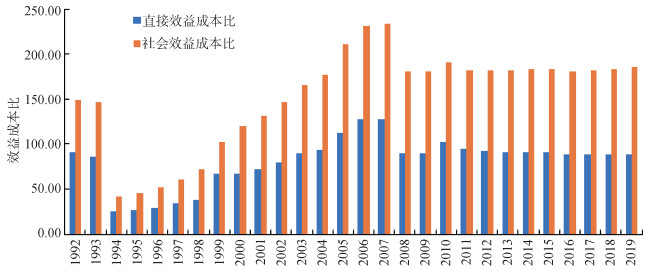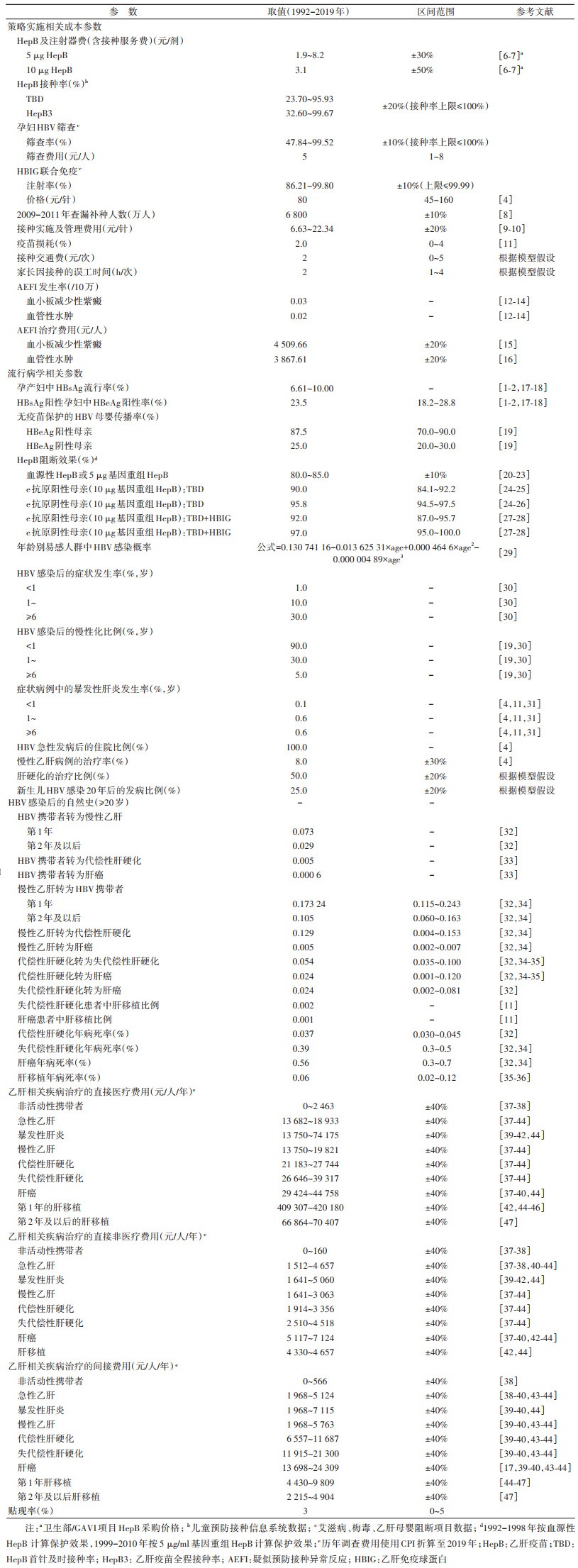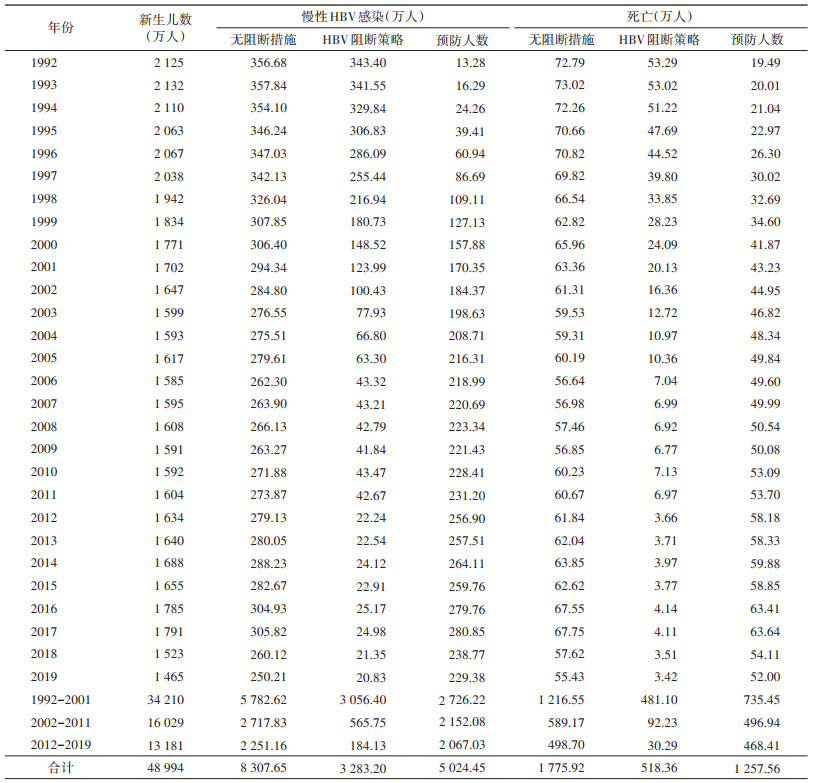文章信息
- 郑徽, 王富珍, 张国民, 缪宁, 梁晓峰, 尹遵栋.
- Zheng Hui, Wang Fuzhen, Zhang Guomin, Miao Ning, Liang Xiaofeng, Yin Zundong
- 中国1992-2019年乙型肝炎疫苗免疫及母婴阻断策略的成本效益分析
- Cost-benefit analysis of the hepatitis B vaccination to prevent mother-to-child transmission strategies in China, 1992-2019
- 中华流行病学杂志, 2021, 42(9): 1537-1545
- Chinese Journal of Epidemiology, 2021, 42(9): 1537-1545
- http://dx.doi.org/10.3760/cma.j.cn112338-20210319-00226
-
文章历史
收稿日期: 2021-03-19
2. 暨南大学基础医学与公共卫生学院, 广州 510632
2. School of Medicine Jinan University, Guangzhou 510632, China
乙型肝炎(乙肝)是严重威胁中国公共卫生的疾病之一。在疫苗应用前,我国属于HBV高流行区,人群HBsAg流行率高达9.75%,约有1.2亿人携带HBV[1-2]。为控制HBV高流行态势,从1985年乙肝疫苗(HepB)上市应用以来,我国积极推进新生儿HepB免疫策略,经历了1992-2001年纳入计划免疫管理(自费接种)、2002-2004年纳入免疫规划(疫苗免费,但收取接种服务费)、2005年以后HepB完全免费接种、2011年开始逐步推进孕产妇HBV筛查及高风险儿童HepB联合乙肝免疫球蛋白(HBIG)免费注射几个阶段[3]。此外,2009-2011年我国还对 < 15岁儿童开展了HepB查漏补种。这些措施极大地降低了我国HBV新发感染,成功地使中国从全球HBV高流行国家降为中等流行国家[3]。本研究从直接和社会的2个维度对1992-2019年我国实施HepB免疫及母婴阻断策略进行成本效益分析,为全面科学评价我国乙肝防控策略提供参考。
资料与方法1. 研究对象:1992-2019年出生的28个出生队列人群。
2. 模型构建:本研究使用Excel 2016软件构建决策分析马尔科夫模型(decision analytic-Markov model)[4]。模型以新生儿不实施HepB免疫及母婴阻断措施为对照,分析按照实时政策对1992-2019年出生队列儿童开展HepB免疫及母婴阻断措施后,所有队列儿童整个生命周期的经济学产出。本模型中包含以下假设:①所有有HepB免疫史儿童均全程接种3剂HepB;② HepB免疫成功后可获得终身保护;③模型不考虑HepB接种后产生的群体免疫效果。模型研究的基准年为2019年,Markov模型循环周期为1年;设定每个出生队列观察100年。本文的决策树框图和Markov模型气泡图参见参考文献[4]。
3. 模型参数:1992-2019年28个出生队列的人口数参考国家统计局数据[5]。本研究HBV感染相关疾病的医疗成本从直接成本(包括直接医疗成本和直接非医疗成本)和社会成本(增加由于HBV感染和过早死亡造成的生产力损失)两个角度进行分析。直接医疗成本包括与患者治疗直接相关的费用,如门诊费、住院费、检测费、药费等;直接非医疗成本包括交通费、营养和患者护理费等。
与干预策略相关的工作成本也包含直接成本和社会成本。其中,直接工作成本包括HepB及注射器费、疫苗损耗、疫苗接种管理及实施经费(含冷链、培训、监测、督导、人员工资、宣传等),其中1992-2004年还增加HepB接种服务费,每剂次HepB接种服务费按2~3元计算;2011年后增加孕妇产前HBV筛查及阳性母亲儿童HBIG费用。社会工作成本还包括因儿童HepB接种造成的父母误工损失。根据1990、2000和2010年人口普查的工资收入数据,通过人力资本法计算不同时间段的生产力损失和误工损失。本研究中所有成本均根据一般消费者价格指数(CPI)调整为2019年人民币[5],未来的成本和效益以3%的贴现率折算。模型主要参数取值见表 1。
本研究中,收益被量化为干预措施实施后因避免HBV感染而减少乙肝相关疾病发病和死亡,从而节省的直接成本和社会成本。最终计算净效益(NPV)和效益成本比(BCR)。NPV和BCR计算公式:

其中,Bi和Ci分别表示第i年的收益和当年策略实施的成本;T表示期望寿命(本文中T为100,即每个出生队列观察100年);r为贴现率。BCR > 1.0表示策略能够节约成本。
4. 敏感性分析:采用单因素敏感性分析的方法评价模型稳定性,并分析影响模型结果的主要因素。敏感性分析的主要参数包括疫苗价格、疫苗效果、贴现率、常规免疫接种率等。见表 1。
结果1. 1992-2019年HepB免疫及母婴阻断策略实施效果:28个出生队列约4.90亿新生儿。模型结果显示,如不实施HepB免疫及HBV母婴阻断措施,4.90亿新生儿终其一生将会有8 307.65万人成为慢性HBV感染者,约1 775.92万人将死于HBV感染相关疾病。在实施HepB免疫及HBV母婴阻断措施后,共保护5 024.45万人免于成为慢性HBV感染者,减少了1 257.56万人死于HBV相关疾病(表 2)。
2. 成本-效益分析:1992-2019年出生队列儿童接种HepB达13.82亿剂次,实施孕产妇产前HBV筛查和HBsAg阳性母亲新生儿HBIG联合免疫策略后,约1 376.31万HBsAg阳性母亲儿童实施了HepB和HBIG联合免疫(表 3)。
1992-2019年中国实施HepB免疫及HBV母婴阻断策略的直接成本和社会成本分别为374.30亿元和476.10亿元;通过减少人群HBV感染和发病所节约的直接医疗成本和社会医疗成本分别为2.89万亿元和6.92万亿元,分别实现直接净效益2.85万亿元和社会净效益6.87万亿元。1992- 2019年我国HepB免疫及母婴阻断策略实施的直接BCR为77.21,社会BCR为145.29(表 3,图 1)。

|
| 图 1 1992-2019年中国乙型肝炎疫苗免疫及母婴阻断策略的效益成本比 |
3. 敏感性分析:见图 2。

|
| 图 2 1992-2019年中国乙型肝炎疫苗免疫及母婴阻断策略的单因素敏感性分析 |
1992-2019年我国实施新生儿HepB免疫和HBV母婴阻断策略,共投入直接成本374.30亿元和社会成本476.10亿元,避免了近5 000万人成为慢性HBV感染者,减少了1 250万人因HBV感染导致的早死,节约了2.89万亿元的直接医疗成本和约6.92万亿元的社会医疗成本,实现直接净效益2.85万亿元和社会净效益6.87万亿元。1992- 2019年我国实施的HepB免疫及母婴阻断策略的直接BCR为77.21,社会BCR为145.29,即从社会成本的角度,国家每投入1元钱,可节省约145元社会医疗成本。我国实施的HepB免疫及母婴阻断策略具有成本-效益收益。
新生儿HepB免疫及母婴阻断策略在我国实施已30年,随着策略的不断推广和完善,我国人群HBsAg流行率从1992年的9.75%下降到2006年7.18%,至2016年模型估算我国人群HBsAg流行率降为6.1%。国内众多学者对新生儿HepB免疫和HBV母婴阻断策略开展过成本效益分析[48-53],虽然在不同时期、不同省份开展的HepB免疫经济学评价中,由于评价时间阶段不同、免疫策略不同、模型构建方法不同等因素造成结果存在差异,但整体可见各研究获得的直接BCR和社会BCR均远超过1.0,与本研究结果一致,充分证实我国的HepB免疫和HBV母婴阻断极具成本效益。本研究采用的决策树-马尔科夫模型在HepB免疫策略的卫生经济学评价中广泛应用[54]。Hadler等[54]使用Goldstein模型估算我国1992-2009年出生队列儿童实施HepB免疫策略,预防了2 400万人成为慢性HBV感染者,与本研究模型估算的该队列人群中HepB预防了2 498万慢性HBV感染者的结果基本一致,证实了本研究模型构建的科学性。
本研究发现,1994-1998年出生队列儿童HepB免疫策略所产生的直接BCR和社会BCR均略低于其他年份,可能与2009-2011年“医疗体制改革重大项目”实施的≤14岁儿童HepB查漏补种工作有关。我国慢性HBV感染主要来源于母婴垂直传播,出生后及时接种首针HepB并完成全程免疫是预防慢性HBV感染最有效措施;随着儿童年龄增长,虽然仍可通过水平传播感染HBV,但感染风险和慢性化比例均明显降低,因此HepB对大年龄儿童免疫的收益也低于新生儿免疫[30]。受HepB供给和经济水平等因素影响,我国早期出生儿童的HepB接种率低,在2009-2011年的查漏补种工作中早期出生队列人群实际补种工作量大,尽管通过查漏补种各出生队列儿童均能基本实现HepB全覆盖,但补种策略产生的收益低于新生儿策略。医改重大项目的实施,充分体现了我国政策对儿童HepB免疫的公平性,尽管个别年份BCR值有所降低,但整体的成本效益依然显著。
本研究分析1992-2019年中国新生儿HepB免疫和HBV母婴阻断措施实施的经济学效果,在模型参数上充分应用了历次全国乙肝血清流行病学调查数据、我国儿童预防接种信息系统的历年新生儿HepB接种率数据、HepB国家采购价格数据及免疫规划疫苗实施成本数据等具有国家代表性资料,模型结果可靠。
本研究存在局限性。首先,在开展社会维度的成本效益分析时,使用人力资本法估算因病造成的生产力损失,但人力资本法难以涵盖工作以外(如休闲、娱乐等)所创造的价值,因此模型对社会维度的净效益值和BCR值估算是保守估算。第二,我国不同地区、不同年份以及不同治疗药物应用对治疗成本影响较大,模型中乙肝相关疾病的治疗成本参数主要来源于文献检索且考虑了不同时间段的差别,但仍可能与真实情况存在差异。模型通过敏感性分析,对各时间段的治疗成本在±40%的范围内浮动,证实结果依然稳定。
利益冲突 所有作者均声明不存在利益冲突
| [1] |
戴志澄, 祁国明. 中国病毒性肝炎血清流行病学调查: 1992-1995(上卷)[M]. 北京: 科学技术文献出版社, 1997. Dai ZC, Qi GM. Viral hepatitis in China-Seroepidemiological survey in Chinese population 1992-1995(part one)[M]. Beijing: Science and Technology Literature Press, 1997. |
| [2] |
卫生部疾病预防控制局, 中国疾病预防控制中心. 全国人群乙型病毒性肝炎血清流行病学调查报告[M]. 北京: 人民卫生出版社, 2011. Bureau for Disease Control and Prevention, Ministry of Health, Chinese Center for Disease Control and Prevention. Seroepidemiological survey of hepatitis B in Chinese population[M]. Beijing: People's Medical Publishing House, 2011. |
| [3] |
刘珏, 刘民. 我国实现WHO 2030消除乙型肝炎目标的进展与挑战[J]. 中华流行病学杂志, 2019, 40(6): 605-609. Liu J, Liu M. Progress and challenges in achieving the WHO goal on 'Elimination of Hepatitis B by 2030' in China[J]. Chin J Epidemiol, 2019, 40(6): 605-609. DOI:10.3760/cma.j.issn.0254-6450.2019.06.001 |
| [4] |
Chen YS, Zheng H, Liu YM, et al. Economic evaluation on infant hepatitis B vaccination combined with immunoglobulin in China, 2013[J]. Hum Vaccin Immunother, 2016, 12(7): 1838-1846. DOI:10.1080/21645515.2016.1141845 |
| [5] |
国家统计局. 国家数据[EB/OL]. (2021-03-01)[2021-03-19]. https://data.stats.gov.cn/. National Bureau of Statistics. National data[EB/OL]. (2021-03-01)[2021-03-19]. https://data.stats.gov.cn/. |
| [6] |
李波, 崔伟红, 衣学梅, 等. 烟台市新生儿乙肝疫苗策略卫生经济学评价[J]. 中国卫生经济, 2013, 32(3): 81-83. Li B, Cui WH, Yi XM, et al. Impact and health economic of hepatitis B vaccination for the infant population in Yantai[J]. Chin Health Econom, 2013, 32(3): 81-83. DOI:10.7664/CHE20130327 |
| [7] |
国家发展改革委员会办公厅. 国家发改委关于制定重组乙型肝炎等14种国家免疫规划疫苗出厂价格的通知[Z]. 2009. General Office of the National Development and Reform Commission. The notification on the factory price of 14 vaccines in explored program on immunization[Z]. 2009. |
| [8] |
Cui FQ, Shen LP, Li L, et al. Prevention of chronic hepatitis B after 3 decades of escalating vaccination policy, China[J]. Emerg Infect Dis, 2017, 23(5): 765-772. DOI:10.3201/eid2305.161477 |
| [9] |
余文周, 金水高, 崔钢, 等. 中国部分地区计划免疫工作经费投入分析[J]. 中国计划免疫, 2005, 11(4): 292-297. Yu WZ, Jin SG, Cui G, et al. Study on financing of expanded program on immunization in some regions of China[J]. Chin J Vacc Immunizat, 2005, 11(4): 292-297. DOI:10.3969/j.issn.1006-916X.2005.04.012 |
| [10] |
Yu WZ, Lu M, Wang HQ, et al. Routine immunization services costs and financing in China, 2015[J]. Vaccine, 2018, 36(21): 3041-3047. DOI:10.1016/j.vaccine.2018.04.008 |
| [11] |
Zheng H, Wang FZ, Zhang GM, et al. An economic analysis of adult hepatitis B vaccination in China[J]. Vaccine, 2015, 33(48): 6831-6839. DOI:10.1016/j.vaccine.2015.09.011 |
| [12] |
张丽娜, 李克莉, 杜雯, 等. 2018年中国疑似预防接种异常反应监测[J]. 中国疫苗和免疫, 2020, 26(4): 363-371. Zhang LN, Li KL, Du W, et al. Surveillance of adverse events following immunization in China, 2018[J]. Chin J Vacc Immun, 2020, 26(4): 363-371. |
| [13] |
许涤沙, 李克莉, 武文娣, 等. 中国2016年疑似预防接种异常反应监测数据分析[J]. 中国疫苗和免疫, 2018, 24(3): 299-309, 322. Xu DS, Li KL, Wu WD, et al. Adverse events following immunization in China, 2016[J]. Chin J Vacc Immun, 2018, 24(3): 299-309, 322. |
| [14] |
李克莉, 张丽娜, 叶家楷, 等. 中国2017年疑似预防接种异常反应监测[J]. 中国疫苗和免疫, 2020, 26(1): 9-18. Li KL, Zhang LN, Ye JK, et al. Surveillance of adverse events following immunization in China, 2017[J]. Chin J Vacc Immun, 2020, 26(1): 9-18. |
| [15] |
陈雁, 宋斌, 王娇娇, 等. 临床路径在特发性血小板减少性紫癜住院病人中的应用[J]. 中国医学工程, 2013, 21(1): 154-155. Chen Y, Song B, Wang JJ, et al. The clinical pathway in idiopathic thrombocytopenic purpura application of hospitalized patients[J]. Chin Med Eng, 2013, 21(1): 154-155. |
| [16] |
姚凤燕, 朱音. 平湖市2010-2011年预防接种不良反应及疾病负担现状分析[J]. 上海预防医学, 2013, 25(2): 71-73. Yao FY, Zhu Y. Analysis of adverse reactions and disease burden of vaccination in Pinghu city, 2010-2011[J]. Shanghai J Prev Med, 2013, 25(2): 71-73. DOI:10.3969/j.issn.1004-9231.2013.02.006 |
| [17] |
郑徽, 崔富强, 龚晓红, 等. 我国育龄期妇女乙型肝炎病毒表面抗原及e抗原流行现状分析[J]. 中国疫苗和免疫, 2010, 16(6): 496-499. Zheng H, Cui FQ, Gong XH, et al. Staus of the hepatitis B virus surface antigen and e antigen prevalence among reproductive women in China[J]. Chin J Vacc Immun, 2010, 16(6): 496-499. |
| [18] |
Zheng H, Cui FQ, Wang FZ, et al. The epidemiology of hepatitis B virus infection in women of reproductive age in highly endemic areas in China[J]. J Viral Hepat, 2018, 25(1): 88-96. DOI:10.1111/jvh.12757 |
| [19] |
Plotkin SA, Orenstein WA, Offit PA. 疫苗[M]. 罗凤基, 杨晓明, 王军智, 等译. 2版. 北京: 人民卫生出版社, 2017. Plotkin SA, Orenstein WA, Offit PA. Vaccine[M]. Luo FJ, Yang XM, Wang JZ, et al, trans. 2nd ed. Beijing: People's Medical Publishing House, 2017. |
| [20] |
封秀红. 乙肝疫苗对HBsAg阳性母亲的新生儿免疫效果长期研究[J]. 河南医学研究, 2002, 11(4): 351-354. Feng XH. A study of long-term efficacy of hepatitis B immunized neonates born to HBsAg positive mothers[J]. Henan Med Res, 2002, 11(4): 351-354. DOI:10.3969/j.issn.1004-437X.2002.04.023 |
| [21] |
Poovorawan Y, Sanpavat S, Chumdermpadetsuk S, et al. Long term hepatitis B vaccine in infants born to hepatitis B e antigen positive mothers[J]. Arch Dis Childhood, 1997, 77(1). DOI:10.1136/fn.77.1.f47 |
| [22] |
夏国良, 贾志远, 颜天强, 等. 新生儿单纯乙型肝炎血源疫苗的免疫持久性和远期保护效果[J]. 中华实验和临床病毒学杂志, 2002, 16(2): 146-149. Xia GL, Jia ZY, Yan TQ, et al. Long-term efficacya and persistence of Chinese infants after receiving only active plasma-derived hepatitis B vaccine[J]. Chin J Exp Clin Virol, 2002, 16(2): 146-149. DOI:10.3760/cma.j.issn.1003-9279.2002.02.010 |
| [23] |
Zhu FC, Sun KX, Pan HX, et al. The immunogenicity in healthy infants and efficiency to prevent mother to child transmission of Hepatitis B virus of a 10μg recombinant yeast-derived Hepatitis B vaccine (Hep-KSC)[J]. Vaccine, 2016, 34(24): 2656-2662. DOI:10.1016/j.vaccine.2016.04.042 |
| [24] |
G Yonghao, D Pumei, Y Jianhui, et al. A retrospective study of hepatitis B mother-to-child transmission prevention and postvaccination serological test results of infants at risk of perinatal transmission in two counties of middle China[J]. J Viral Hepat, 2017, 24(8): 687-695. DOI:10.1111/jvh.12694 |
| [25] |
Wang FZ, Zhang GM, Zheng H, et al. Post-vaccination serologic testing of infants born to hepatitis B surface antigen positive mothers in 4 provinces of China[J]. Vaccine, 2017, 35(33): 4229-4235. DOI:10.1016/j.vaccine.2017.06.019 |
| [26] |
Lu Y, Liang XF, Wang FZ, et al. Hepatitis B vaccine alone may be enough for preventing hepatitis B virus transmission in neonates of HBsAg (+)/HBeAg (-) mothers[J]. Vaccine, 2017, 35(1): 40-45. DOI:10.1016/j.vaccine.2016.11.061 |
| [27] |
周乙华, 胡娅莉. 预防乙型肝炎母婴传播的乙肝免疫球蛋白合理剂量: 100 U单次注射[J]. 中华围产医学杂志, 2018, 21(2): 109-111. Zhou YH, Hu YL. Hepatitis B immunoglobulin in prevention of maternal-fetal transmission of hepatitis B: 100 U once[J]. Chin J Perinat Med, 2018, 21(2): 109-111. DOI:10.3760/cma.j.issn.1007-9408.2018.02.008 |
| [28] |
Qiao YP, Su M, Song Y, et al. Outcomes of the national programme on prevention of mother-to-child transmission of hepatitis B virus in China, 2016-2017[J]. Infect Dis Poverty, 2019, 8(1): 65. DOI:10.1186/s40249-019-0576-y |
| [29] |
沈艳辉, 崔丽, 张卫, 等. 北京市人群病毒性乙型肝炎表面抗原携带率仓室预测模型建立和控制策略分析[J]. 国际病毒学杂志, 2012, 19(3): 97-101. Shen YH, Cui L, Zhang W, et al. Development of epidemioiogical compartmental model for HBsAg carrier rate and control policy analysis in Beijing[J]. Int J Virol, 2012, 19(3): 97-101. DOI:10.3760/cma.j.issn.1673-4092.2012.03.001 |
| [30] |
World Health Organization. Hepatitis B vaccines: WHO position paper, July 2017-Recommendations[J]. Vaccine, 2019, 37(2): 223-225. DOI:10.1016/j.vaccine.2017.07.046 |
| [31] |
Jia YX, Li L, Cui FQ, et al. Cost-effectiveness analysis of a hepatitis B vaccination catch-up program among children in Shandong province, China[J]. Hum Vaccin Immunother, 2014, 10(10): 2983-2991. DOI:10.4161/hv.29944 |
| [32] |
Kim SY, Billah K, Lieu TA, et al. Cost effectiveness of hepatitis B vaccination at HIV counseling and testing sites[J]. Am J Prev Med, 2006, 30(6): 498-506.e6. DOI:10.1016/j.amepre.2006.01.017 |
| [33] |
Fan L, Owusu-Edusei K, Schillie SF, et al. Cost-effectiveness of active-passive prophylaxis and antiviral prophylaxis during pregnancy to prevent perinatal hepatitis B virus infection[J]. Hepatology, 2016, 63(5): 1471-1480. DOI:10.1002/hep.28310 |
| [34] |
Hoerger TJ, Schillie S, Wittenborn JS, et al. Cost-effectiveness of hepatitis B vaccination in adults with diagnosed diabetes[J]. Diabetes Care, 2013, 36(1): 63-69. DOI:10.2337/dc12-0759 |
| [35] |
Wong WWL, Woo G, Heathcote EJ, et al. Disease burden of chronic hepatitis B among immigrants in Canada[J]. Can J Gastroenterol, 2013, 27(3): 137-147. DOI:10.1155/2013/924640 |
| [36] |
Toy M, Onder FO, Idilman R, et al. The cost-effectiveness of treating chronic hepatitis B patients in a median endemic and middle income country[J]. Eur J Health Econ, 2012, 13(5): 663-676. DOI:10.1007/s10198-012-0413-8 |
| [37] |
乔富宇, 吴明. 北京市西城区乙肝病毒感染相关疾病直接经济负担研究[J]. 首都公共卫生, 2011, 5(6): 247-251. Qiao FY, Wu M. A study on direct economic burden of diseases related to hepatitis B viral infection in Xicheng district of Beijing[J]. Cap J Public Health, 2011, 5(6): 247-251. DOI:10.3969/j.issn.1673-7830.2011.06.003 |
| [38] |
李雁, 王怀, 张卫, 等. 北京市HBV感染不同结局患者费用调查[J]. 基础医学与临床, 2014, 34(9): 1235-1240. Li Y, Wang H, Zhang W, et al. Investigation on the cost of patients with different outcomes related to hepatitis B virus infection in Beijing[J]. Basic Clin Med, 2014, 34(9): 1235-1240. DOI:10.3969/j.issn.1001-6325.2014.09.015 |
| [39] |
李晓强. 乙肝相关疾病住院病人经济负担和生存质量研究[D]. 银川: 宁夏医科大学, 2012. DOI: 10.7666/d.d225087. Li XQ. Economic burden and quality of life in patients with Hepatitis B-related diseases[D]. Yinchuan: Ningxia Medical University, 2012. DOI: 10.7666/d.d225087. |
| [40] |
史武杰. 长治地区乙肝相关疾病经济负担研究[D]. 太原: 山西医科大学, 2011. DOI: 10.7666/d.d157142. Shi WJ. The Disease Burden of Hepatitis B related diseases in Changzhi[D]. Taiyuan: Shanxi Medical University, 2011. DOI: 10.7666/d.d157142. |
| [41] |
Lu JJ, Xu AQ, Wang J, et al. Direct economic burden of hepatitis B virus related diseases: evidence from Shandong, China[J]. BMC Health Serv Res, 2013, 13: 37. DOI:10.1186/1472-6963-13-37 |
| [42] |
马起山, 邹宇华, 张顺祥, 等. 广州市乙型肝炎相关疾病直接经济负担及其影响因素分析[J]. 中国预防医学杂志, 2011, 12(5): 383-386. Ma QS, Zou YH, Zhang SX, et al. Analysis on the direct economic burden and influence factors of HBV-related diseases in Guangzhou[J]. China Prev Med, 2011, 12(5): 383-386. DOI:10.16506/j.1009-6639.2011.05.019 |
| [43] |
李俊华, 刘近春, 张顺祥, 等. 山西省太原地区乙型病毒性肝炎经济负担影响因素分析[J]. 中国现代医生, 2011, 49(9): 103-105, 109. Li JH, Liu JC, Zhang SX, et al. Research on the ecnomic burden and its influencing factors of the patients suffering from Type B viral hepatitis in Shanxi Taiyuan[J]. Chin Mod Docter, 2011, 49(9): 103-105, 109. DOI:10.3969/j.issn.1673-9701.2011.09.053 |
| [44] |
马起山, 梁森, 肖和卫, 等. 中国12个地区乙型肝炎相关疾病住院患者经济负担调查[J]. 中华流行病学杂志, 2017, 38(7): 868-876. Ma QS, Liang S, Xiao HW, et al. Survey of economic burden of hepatitis B-related diseases in 12 areas in China[J]. Chin J Epidemiol, 2017, 38(7): 868-876. DOI:10.3760/cma.j.issn.0254-6450.2017.07.005 |
| [45] |
王德臣, 宋世兵, 袁炯, 等. 肝移植术前状态对住院费用的影响[J]. 中国普通外科杂志, 2004, 13(8): 606-608. Wang DC, Song SB, Yuan J, et al. Influence of preoperative status on the cost of liver transplantation[J]. Chin J General Surgery, 2004, 13(8): 606-608. DOI:10.3969/j.issn.1005-6947.2004.08.013 |
| [46] |
高琴. 某器官移植中心肝、肾移植患者费用负担研究[D]. 长沙: 中南大学, 2007. DOI: 10.7666/d.y1326546. Gao Q. Economic analysis for liver and renal transplant in a transplant center[D]. Changsha: Central South University, 2007. DOI: 10.7666/d.y1326546. |
| [47] |
宋建华, 冯扣兰. 肝移植手术时机的选择与治疗费用[J]. 川北医学院学报, 2007, 22(5): 464-466. Song JH, Feng KL. Study on the cost and operation time selection for liver transplantation[J]. J North Sichuan Med College, 2007, 22(5): 464-466. DOI:10.3969/j.issn.1005-3697.2007.05.019 |
| [48] |
王溪, 袁淑婷, 郭艺玮, 等. 1992-2013年北京市乙型肝炎疫苗接种预防慢性乙型肝炎成本效益[J]. 中国疫苗和免疫, 2019, 25(4): 397-400. Wang X, Yuan ST, Guo YW, et al. Cost-benefit analysis of hepatitis B vaccination for preventing chronic hepatitis B in Beijing during 1992-2013[J]. Chin J Vacc Immun, 2019, 25(4): 397-400. |
| [49] |
Polaris Observatory Collaborators. Global prevalence, treatment, and prevention of hepatitis B virus infection in 2016:a modelling study[J]. Lancet Gastroenterol Hepatol, 2018, 3(6): 383-403. DOI:10.1016/S2468-1253(18)30056-6 |
| [50] |
叶莉霞, 方挺, 马瑞, 等. 宁波市实施乙肝疫苗纳入免疫规划策略的经济学评价[J]. 中国卫生经济, 2019, 38(8): 56-59. Ye LX, Fang T, Ma R, et al. Health Economic evaluation on hepatitis B vaccination introduced into national expanded programme on immunization in Ningbo[J]. Chin Health Econom, 2019, 38(8): 56-59. DOI:10.7664/CHE201908014 |
| [51] |
梁森. 中国新生儿乙肝免疫预防策略决策分析和成本效益评价[D]. 郑州: 郑州大学, 2011. DOI: 10.7666/d.y1929987. Liang S. Analysis on decision-making and cost-benefit of infant hepatitis B immunization strategies in China[D]. Zhengzhou: Zhengzhou University, 2011. DOI: 10.7666/d.y1929987. |
| [52] |
张顺祥, 党如波, 张卫东, 等. 中国乙型肝炎疫苗免疫预防效果和现行策略的经济学和决策学评估[J]. 中华流行病学杂志, 2008, 29(10): 1003-1008. Zhang SX, Dang RB, Zhang WD, et al. Analysis on economic efficacy regarding previous strategies and current recommendations for vaccination against hepatitis B virus in China[J]. Chin J Epidemiol, 2008, 29(10): 1003-1008. DOI:10.3321/j.issn:0254-6450.2008.10.012 |
| [53] |
张吉凯, 赵占杰, 邵晓萍, 等. 广东省乙肝疫苗纳入免疫规划四年成本-效益分析[J]. 华南预防医学, 2008, 34(5): 58-60. Zhang JK, Zhao ZJ, Shao XP, et al. Analysis of cost-benefit after hepatitis B vaccine was introduced into EPI for 4 years in Gnangdong province[J]. South China J Prev Med, 2008, 34(5): 58-60. DOI:10.3969/j.issn.1671-5039.2008.05.019 |
| [54] |
Hadler SC, Fuqiang C, Averhoff F, et al. The impact of hepatitis B vaccine in China and in the China GAVI Project[J]. Vaccine, 2013, 31(Suppl 9): J66-72. DOI:10.1016/j.vaccine.2013.03.043 |
 2021, Vol. 42
2021, Vol. 42





